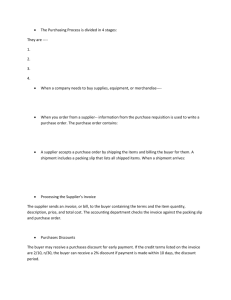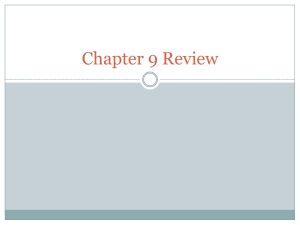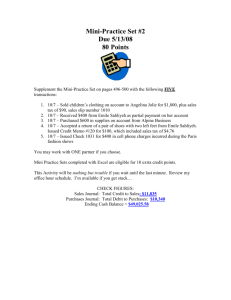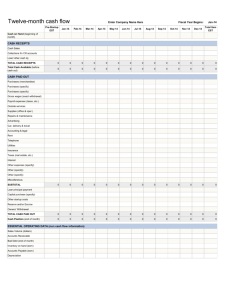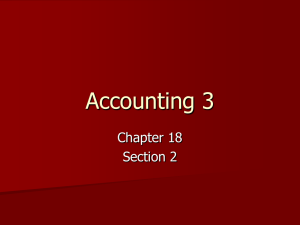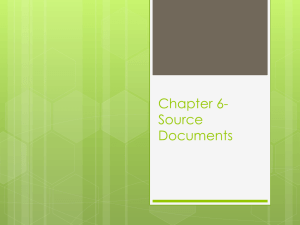Slides Chpt 15
advertisement
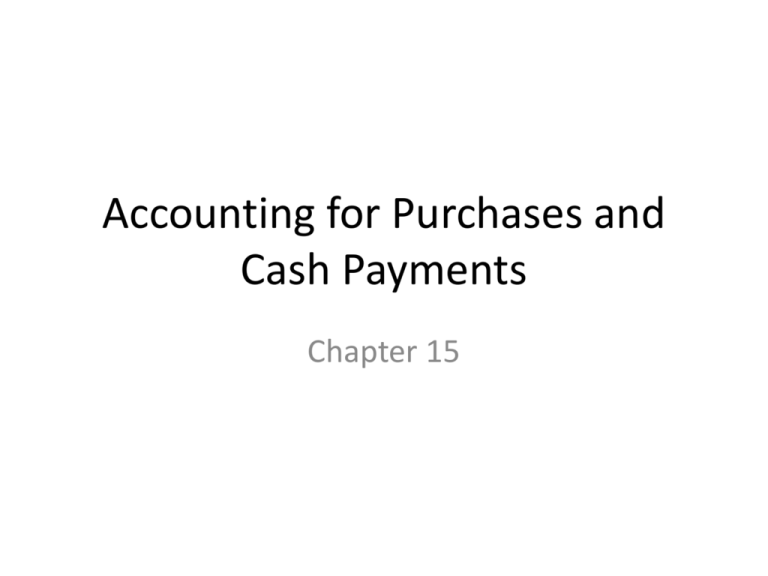
Accounting for Purchases and Cash Payments Chapter 15 15-1 Purchasing Items Needed The Purchasing Process 1. Requesting needed items • • 2. In a small business the owner does all the ordering In a large business departments have designated people in charge of approving purchase requisitions (written request to order a specified item or items) Ordering from a supplier • • 3. A purchase order (written offer to the supplier to buy specified items) is submitted to the supplier The information on the purchase order comes from the requisition form Verifying items received • 4. When the supplier ships to the buyer, the shipment includes a packing slip (a form that lists the items included in the shipment). That is then checked against what has actually been sent. Processing the supplier’s invoice • • • Once the supplier sends out the item(s) it prepares an invoice (bill) and sends it to the customer The receiver checks the invoice against the packing slip to check that they are being billed for what was received. The invoice is marked with a processing stamp which accounts for: – – – – The date the invoice is to be paid The discount amount (if any) The amount to be paid Check number of payment Pg 416-418 Pg 417, 419 Vouchers and Purchases Discounts • When a small business grows too large for one person to handle all the financial responsibilities, it may adopt the Voucher System to provide internal control. A voucher is a document that serves as written authority for a cash payment • Purchases Discount – suppliers offer charge customers a discount for early payment. For the buyer the discount is called a purchases discount. The discount period is the time within the invoice must be paid to take the discount Pg 418-419 The Purchases Account • Purchases account – when a business buys merchandise to sell, the cost is recorded in this account – It is a temporary account – It is classified as a Cost of Merchandise account (actual cost of the merchandise as it was sold to the business) – Purchases is a cost of doing business so it is recorded like an expense • Increased with a debit • Decreased with a credit Pg 419 15-2 Analyzing and Recording Purchases on Account • Purchases of Assets on Account Pg 423-424 – Accounts Payable Subsidiary Ledger – keeps track of each individual supplier and the amount the business owes to it. – Accounts Payable Account – records the total amount owed to all suppliers. It is a controlling account – Subsidiary Ledgers • In manual accounting systems subsidiary accounts are arranged in alphabetical order with no account numbers • In computerized accounting systems subsidiary accounts are arranged alphabetically and assigned numbers • Merchandise Purchases on Account – Once journalized and posted, invoices are placed in a tickler file by date they are to be paid so a business doesn’t forget to make the check and actually pay the bill. • Other Purchases on Account – Supplies, computers, store equipment, etc. are journalized the same way, except the debit is not to purchases and is instead to the asset account affected Purchases Returns and Allowances • Purchase Return – when a business decides to return an item that was originally meant to be resold • Purchase Allowance – when a business keeps an item to resell that is less than what they expected and so is compensated by the seller by a reduced price • Debit Memorandum – both the purchases return and purchases allowance are recorded with a debit memo which offsets the amount owed in accounts payable Pg 424-425 Pgs 424, 426 15-3 Analyzing and Recording Cash Payments Cash Controls – Require proper authorization of all cash payments with an approved source document – Write checks for all payments and only allow authorized persons to sign checks Pg 429 – Use pre-numbered checks – Retain and account for spoiled checks (Void) Recording Cash Purchase of Insurance • Insurance Premium – the cost of a policy for a given amount of time – The premium is paid in advance. The unused portion is an asset to the business called Prepaid Insurance Pg 429-430 Cash Transactions • Recording Cash Purchases of Merchandise • Recording Cash Payments for Items Purchased on Account Pgs 430-433 – If no discount taken: debit A/P and the account affected in the subsidiary ledger and credit cash – If a discount is taken: debit A/P and the account affected in the subsidiary ledger and credit cash and the contra account Purchases Discount • Shipping Fees (FOB means Free On Board) – FOB destination – means the supplier is paying shipping – FOB shipping point – means the buyer is paying shipping • The charge is a cost of merchandise account called Transportation In – It is journalized like an expense: Increase with a debit, decrease with a credit • Bankcard Fees – Banks charge a fee for processing a business’ credit card transactions. The fee is usually just taken out of the checking account by the bank. – The amount is debited to Bankcard Fees Expense and cash is credited
